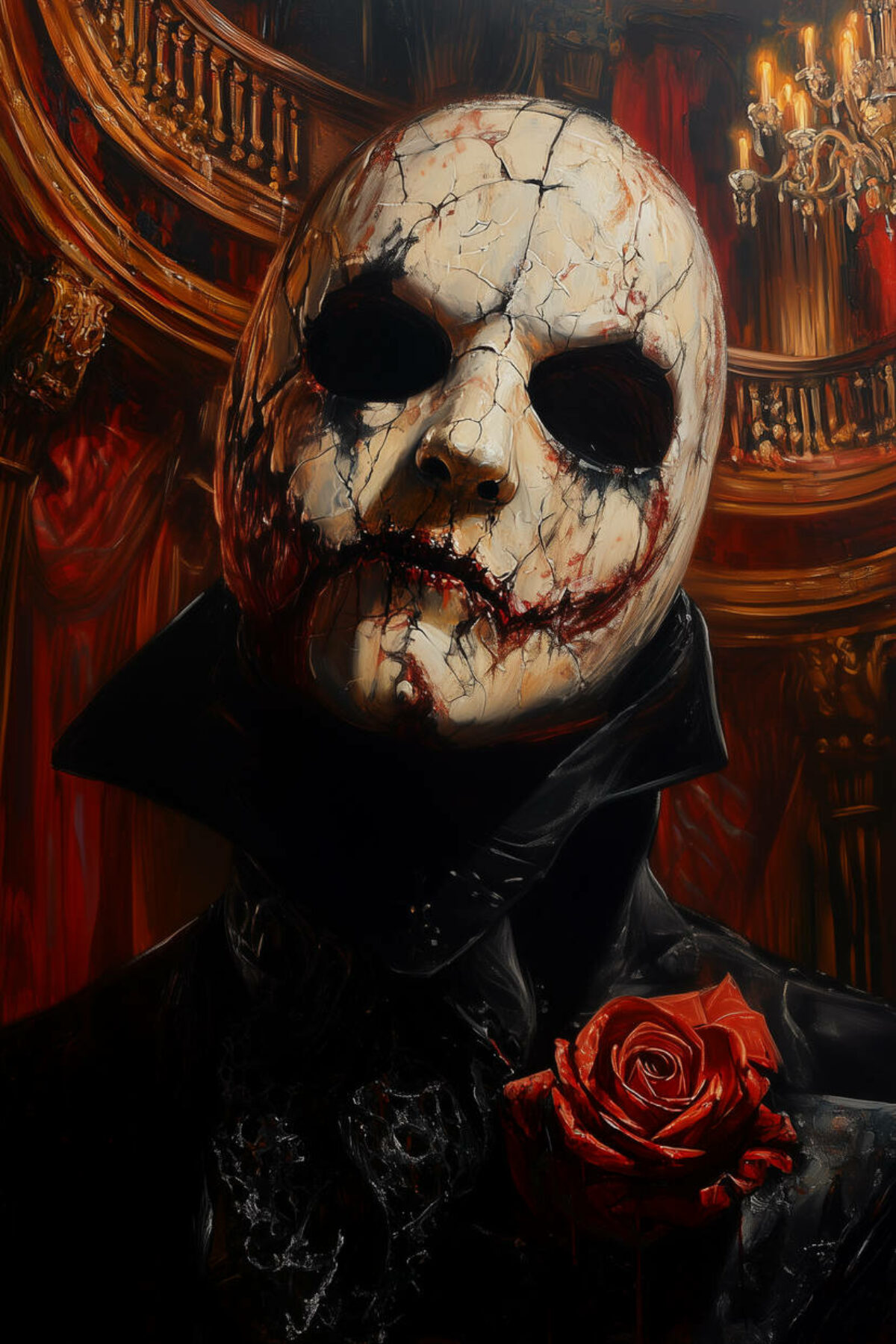THE PHANTOM’S EPILOGUE
New York City, March 1920
I am dying – this time, I believe, for real. I have not left my chambers on the twelfth floor of the Chatsworth in Manhattan for several weeks now, too feeble to leave my bed. George and Mary Carpenter, the husband and wife who serve as my caretakers, reside in the apartment just below. I have not seen them in three days. It is I who employ them, and it is through my beneficence that they reside in one of the most coveted buildings on the Upper West Side. Yet now, even they seem to have withdrawn from me, as if my demise was already whispering through the walls.
For this reason I take pen to paper, to leave record of what I have been, and what I have done. I will leave this record sealed in an envelope with instructions to open only upon my death. My name is Erik Leroux, though here in New York I have lived under the name Erik Garnier. If that name stirs some dim recollection, perhaps you have heard the stories told in hushed tones of the legends that cast me as the Phantom of the Opera, in the days of my exile beneath the Palais Garnier in Paris.
Like a fool, or perhaps a man possessed, I came here in pursuit of Christine Daaé, the only light to ever enter the hollow of my soul. She believed me dead in 1910 and fled with that imbecile Raoul de Chagny. But through the broken ramblings of that old busybody Madame Valérius, extracted with some… persuasive insistence, I learned the destination they sought to hide from me.
By the time I arrived in this vast city, it was too late. My beloved Christine had perished, taken by complications in childbirth of a daughter. Christine now rests in a private mausoleum in Trinity Church Cemetery, my gift to her memory. I go there sometimes, when I am most lonely. Her daughter, alas, was claimed during the Great Influenza epidemic of 1918, while residing in the Franklin Orphanage in Manhattan, where I had been sending her money anonymously. Having no heirs of my own, it is to them I am leaving my fortune in hopes they may better provide for other homeless and outcast urchins.
I decided to remain in Manhattan after learning of Christine’s demise, taking up residence at the spacious Chatsworth, not far from the Metropolitan Opera House. I often attended performances from my private box, arriving by carriage with George, who had arranged for my discreet entrance through a side door so I might avoid interaction with the rest of the audience.
I saw nearly every new production the Met offered: Mona, Cyrano, Madeleine, Madame Sans-Gêne, Goyescas, The Canterbury Pilgrims, Shanewis, Il Trittico, The Legend, and The Temple Dancer. My preferred performance was Walter Damrosch’s Cyrano, especially Frances Alda’s haunting rendition of “You Have Made Me Love.” I attended it weekly for its entire run.
Nearly all of the stories attributed to me at the Palais Garnier Opera House in Paris are true. Having learned the construction trade from my father, I left my hometown in Normandy and fled to Paris, where I found work in the circus. Eventually, I would establish my own construction business and was granted the contract to repair the Palais. It was there I fell in love with opera, and later, with Christine Daaé.
I can admit this now: I was the true author of the opera Le Fantôme de l’Opéra in 1910, not Gaston Leroux who took credit. However, I did not set the fire on the roof that caused the chandelier to crash down upon the audience. I believed it was the doing of that unseemly stagehand, Joseph Buquet, so I hung him.
But it was Christine, the Swedish soprano, who drove me to madness with love. She called me her Angel of Music, for it was I who trained her voice, who played the violin for her as she wept at her father’s grave. Yet, she rejected me and reviled me for my deformities. Most of them I had surgically corrected after I arrived in New York, but in my so-called Phantom days, I wore the mask.
It was I who wrote the letter demanding the managers cast Christine as Marguerite in Faust, not that wretched Carlotta. I requested that Box Five be left unoccupied. They ignored me. What followed was Carlotta’s tragic and well-deserved demise.
When I finally abducted Christine and brought her to my lair beneath the Opera House, I removed my mask to reveal myself to her. I will never forget the look of horror on her face. Still, I let her go on the condition that she wear my ring and remain faithful to me.
Had she truly meant to marry me, as she once agreed, I would have been the happiest of souls. None of the later tragedies would have occurred. But she pitied me. Pity is the cruelest kind of love.
When I deliberate upon the shame she bestowed upon me and her eventual elopement with Raoul, it ignites a rage so consuming that I have, at times, unleashed it upon others. Their fates became silent screams in the streets of New York, their murders dismissed by the constabulary as mere Mafioso squabbles that were unsolved and forgotten. While I can recall some of these killings with a horrible clarity, others are swallowed in the abyss of my fading memory. It is with grim acceptance I came to understand why some liken me to that tormented soul in Stevenson’s tale, Dr. Jekyll and his monstrous double.
In Paris, I knew the people I murdered. Here in America, they were merely strangers, victims of my vengeance against a God who cursed me with this visage. My disfigurement was so profound my mother could scarcely look upon me, recoiling as though I were something unholy. It became my first education in shame.
Of all the deaths I’ve dealt, a few stand out, particularly Raoul’s among them. His demise still brings a measure of satisfaction. I remember the look on his face of sheer horror when he realized I had found him. He stammered something about Christine’s death and offered pitiful excuses for placing their daughter in an orphanage. I slipped my dagger into his heart mid-sentence and watched the blood drain from him, slow and certain. That evening, George and I disposed of his body in the landfill known as Dead Horse Bay, in Brooklyn, where it lies still beneath the rubble and rot.
But there is one I must speak of now, not out of pride, but for the record: the disappearance of Miss Dorothy Arnold, the socialite who vanished in December 1910 and whose absence set the newspapers aflame with speculation.
I had just arrived in New York, still flushed with desperation, having visited a surgeon who had offered to alleviate my deformities, though not nearly to the degree hoped. As I made my way up Fifth Avenue, my mind adrift, I stopped before a bookstore window, distracted by the tomes arranged in the storefront. It was then that Dorothy appeared. We collided as she turned from a conversation with another woman. The impact knocked my hat to the pavement and dislodged the folds of my cloak, revealing my face in full, to her horror.
I began to sincerely apologize as she looked upon me, mouth agape, and laughed. Not nervously, but cruelly. She turned her back on me, as though I were beneath even a second glance. Her companion, too, smirked, an echo of mockery.
I was consumed by shame and fury. I stumbled through the alleys, desperate and searching. A few blocks on, I found her exiting a haberdashery, clutching a new bonnet. Without hesitation, I pulled her into a narrow alley and down into the shadows.
Later I would learn she was heiress to a prominent cosmetics fortune. The New York Tribune printed daily dispatches on her disappearance. The explanation why the police never found her is simple: she remains sealed within the walls of my apartment. At the time, I was having renovations done. Her body, dismembered with precision, was sealed behind the freshly laid plaster of my grand library, her final resting place entombed within its walls. She lies there still, bonnet and all, for any fool who wishes to peel back the walls of my shame.
Writing this testament has drained what little strength I have left. I must lie down once more. If able, I shall endeavor to write more of my life.



